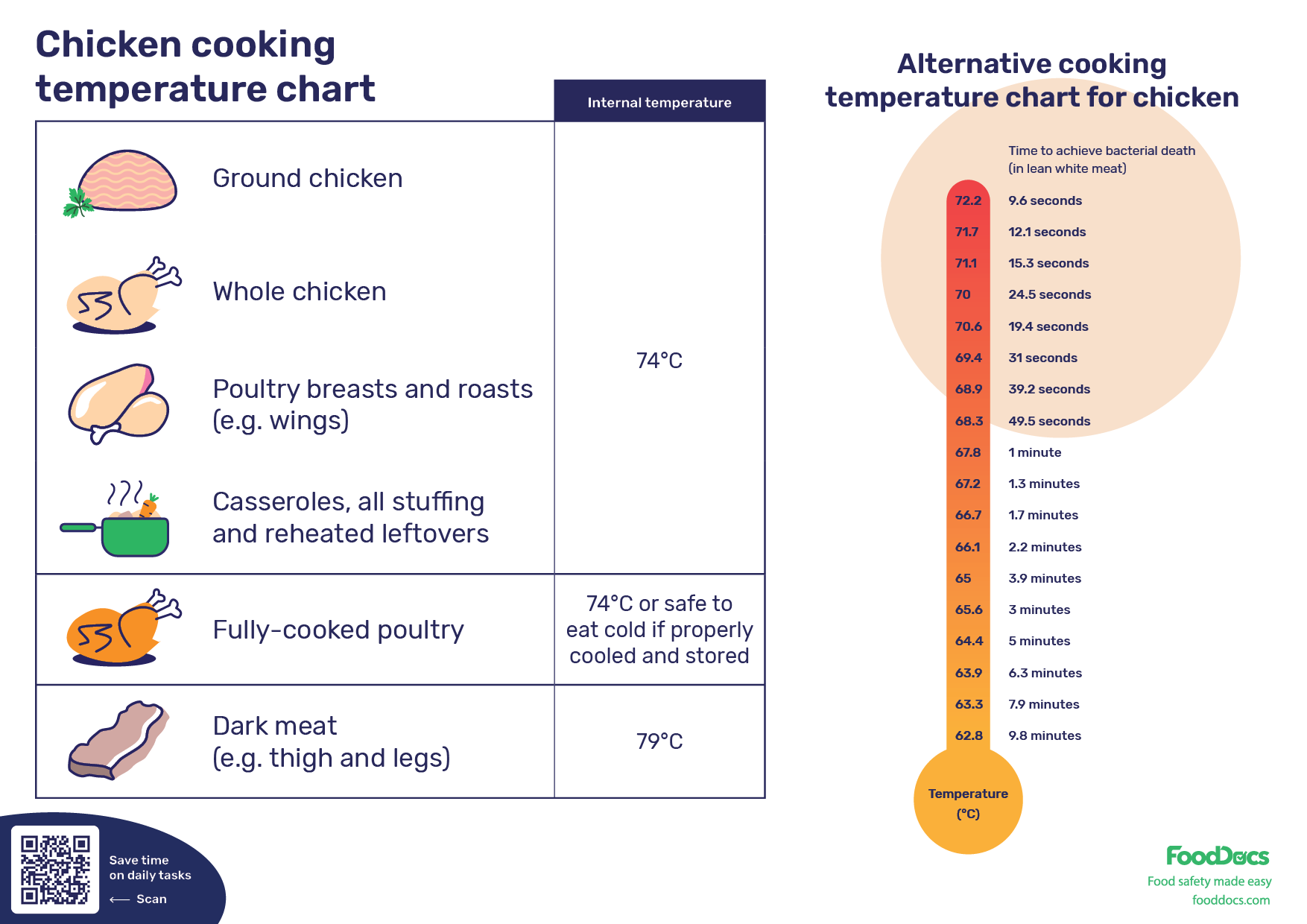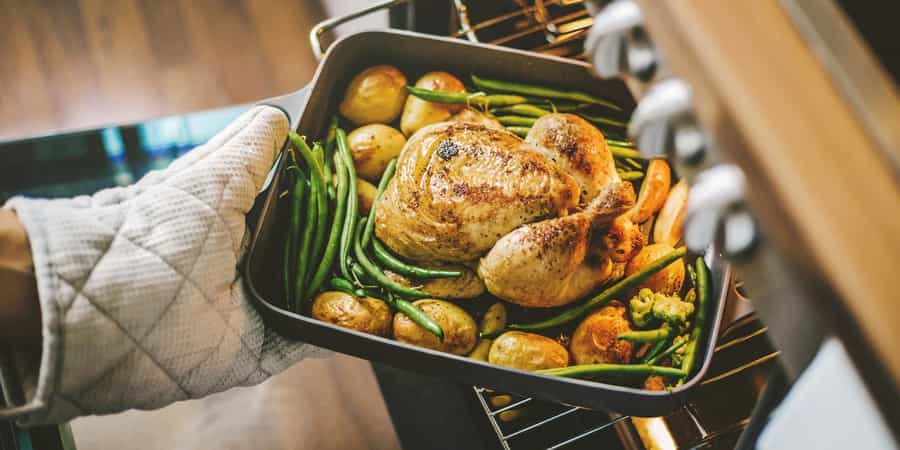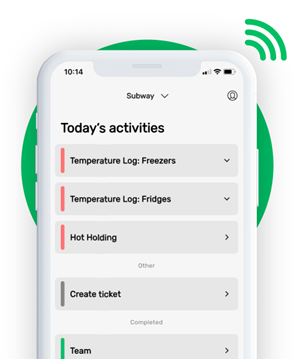CHICKEN TEMPERATURE CHART


This is how our Digital Food Safety platform saves 20% of your time on daily tasks:
- Get upcoming task notifications
- Add data into the app
- Check the status of tasks in real-time

When food safety was still handled on paper, I typically spent a couple of hours per day getting the papers and going around checking or completing tasks… Now I can sit down and it's just all there in one place. It takes me 5-10 minutes.
Ruth B.
Store Manager
Chicken temperature chart
Poultry meat is a very popular protein and everyday food for weight-conscious people and all-around food lovers. We wouldn't be surprised at all by this fact because aside from being very versatile, chicken meat contains very high protein, good nutritional quality, and low-fat content. Despite this, the consumption of undercooked meat has had its fair share of bad reports over the decades. Several foodborne disease cases have been linked to eating undercooked chicken. Cooking chicken to the correct and safe temperature is a critical control point in any cooking method. A chicken temperature chart and a clean food thermometer are your best weapon to ensure proper cooking of chicken meat.
In the United States alone, the Center for Disease Centers and Prevention reported that at least 1 million people get foodborne illnesses from contaminated chicken meat. To ensure that every meal with chicken as the main protein is safe for consumption, proper food handling practices that include accurate cooking must always be applied.
Learn the importance of cooking chicken to the correct internal temperature and how to use a chicken temperature chart to achieve this goal in this article.
What is a chicken temperature chart?
A chicken temperature chart is a visual tool that food handlers can use as a reference in cooking chicken to the correct internal temperature. It contains a complete list of the different cuts of chicken, the suggested internal temperature for chicken, and the corresponding chicken cooking time. Generally, chicken cuts such as chicken wings and chicken breasts are suggested by food agencies to be cooked at 74°C, especially for the white meat. On the other hand, dark meat such as chicken thigh meat and chicken leg meat is suggested to be cooked to an internal temperature of 79°C.
While versatile and easy to cook using traditional methods, much attention must be given when processing chicken to achieve safe and perfect meats. This type of meat is highly associated with well-known foodborne pathogens such as Clostridium perfringens, Campylobacter, and Salmonella. Of all of these pathogens, Salmonella has been reported to be the main culprit in many food poisoning cases. This is because this microbial pathogen naturally lives on any piece of chicken and other poultry meat and is a bit more heat resistant than other pathogens.
Despite these facts and statistics, there is absolutely no reason to avoid chicken. Thermal inactivation such as when using a hot skillet or medium-high heat for water bath temperature of such harmful bacteria is easy for chicken recipes. What you have to avoid, as a food business owner, is to serve undercooked chicken. Unlike different cuts of pork such as pork tenderloin or pork chop that can be served as medium doneness, chicken dishes cannot be undercooked on any occasion.
Who needs a chicken temperature chart?
A chicken temperature chart is a very useful tool for food handlers working in any establishment dealing with poultry. Food establishments such as restaurants, cafeterias, cafes, food trucks, grocery stores, and others could all benefit from this chicken internal temperature guide. Chicken is a very common protein and is widely used in many food establishments. As such, care in prepping must always be observed to ensure that your consumers are safe.

How to check the temperature of chicken?
Knowing how to check temperature of chicken is an essential task for any food handler; even for a home-cook. The best way to check whether safe temperatures have been reached during cooking, you should use an accurate meat thermometer. Different types of any accurate thermometer such as a digital thermometer or instant-read thermometer work best especially in a high-traffic kitchen. In measuring the internal temperature, insert the sanitized end of the thermometer probe during conventional cooking methods. Identify the thickest part of the chicken and puncture it with the probe. The thickest part would be the chicken breast meat.
Accurate thermometer readings ensure that the coldest part of the chicken, which is the center of the breast part, is heated to the target internal temperature. Uneven cooking can result in unsafe food for consumption.
To help you understand more about the important cooking tips for chicken, here are some common questions people ask:
-
Is 145 degrees safe for chicken?
According to the Food and Drug Administration Food Code, chicken meat or poultry must be cooked to an internal temperature reading of 74°C using a digital meat thermometer. Despite this, chicken can be safely cooked at 62.8°C as long as this internal temperature is constantly held at 9.8 minutes based on the guidelines from USDA pasteurization tables. Check out our Chicken meat temperature chart to know other ideal cooking suggestions for time-temperature combinations for chicken.
-
What temp should chicken be cooked to?
White meat from chicken, including ground poultry, must be cooked at 74°C, whereas dark meat can be cooked at 79°C. Dark meat generally has more cartilage and connective tissue collagen that protect the meat from becoming dry and retain chicken juices at high temperatures.
-
Is it okay if chicken is a little pink?
According to the USDA, as long as the coldest part of the chicken meat is heated to an internal temperature of 74°C, the chicken is safe to eat. The color of meat is not a good indicator of doneness since even some fully cooked chicken can have pinkish color on some parts.
-
Why can't you eat raw chicken but can eat raw beef?
Raw chicken naturally contains active bacteria such as Salmonella which requires a constant high temperature to be killed, whereas the known pathogens in beef and other meat products require less heating temperature and minimum cooking time to render the food safe.
What are the benefits of a chicken temperature chart?
Cooking chicken is a very crucial task. Slightly undercooking chicken can be dangerous for consumers especially those under the high-risk groups. Consumers that are pregnant, children under 5, the elderly, and immunocompromised individuals are all vulnerable to foodborne illnesses from eating raw chicken. As such, food handlers must be aware of any minimum safe cooking temperature as well as alternative approximate heating time and temperature combinations for cooking chicken.
Here are some benefits that you get when cooking chicken with a chicken temperature chart as your guide:
- Reminder. Handing chicken in a food establishment entails several basic food handling practices. To minimize the risk of spreading biological hazards, your chicken meat must always be cooked to the correct internal meat temperature. A chicken meat temperature chart can serve as a guide to remind food handlers of the significance of the parameters to safety and sensory quality. Especially in a restaurant that deals with multiple dishes, they may sometimes need to be reminded to ensure that their cooking process for any piece of meat is correct.
- Food safety assurance. Undercooking chicken meat can significantly cause serious foodborne illnesses. Food poisoning due to consuming undercooked chicken is one of the leading causes of foodborne diseases in the US. With a chicken meat temperature chart, food business owners and food handlers can be sure about the target temperature for cooking chicken and prevent any foodborne illness.
- Food safety training. A chicken temperature chart can serve as training material for food employees. There is absolutely no reason to memorize all recommended cooking temperatures but using different cooking temperature charts can help familiarize food handlers with this food safety practice. Additionally, introducing these charts to your employees can become an avenue to orient them about the importance of food safety.
- Food safety awareness. In addition to food handlers, consumers can also use this chicken temperature chart. Misguided cooking procedures and parameters in homes can become a source of foodborne illness. To help control this risk, consumers can download this chicken temperature chart.
In addition to a chicken cooking temperature chart, there are other cooking temperature charts that can be used as a guide in the kitchen. Head over to our HACCP plan template hub and discover a range of reference charts, checklists, and posters. You can download them for free and use them in your operations.
How to create a chicken temperature chart?
Your chicken temperature chart can just be your saving grace from spreading foodborne illness from the food you serve. If you plan on making a chicken temperature chart of your own, you can.
You just have to follow a few key elements to make sure that it functions just the way you need it to:
- Based on facts. A chicken cooking temperature chart aims to ensure that you follow the necessary guidelines mandated by food regulatory agencies. As such, the information you put in your chart must be accurate and based on facts from scientific reports. If you want to use lower temperatures to cook your chicken dishes, use the established time and temperature chart from the USDA. These combination parameters have been tested to reduce the likelihood of getting a foodborne illness from eating cooked chicken.
- Updated. Similar to the updated cooking temperature for pork, other suggested safe cooking temperatures are regularly updated in scientific reports. These reports are then validated and adopted by food agencies as safety standards. When making your chicken cooking temperature chart, check for updates.
- Clear. Especially in a fast-paced kitchen, all information in any cooking temperature chart must be clear. Values and names of chicken cuts must be readable from afar to avoid confusion and for easier identification.
You can hire a professional to draft a great-looking chicken temperature chart, but remember to apply these key elements to ensure its effectiveness. Alternatively, and even easier, you can download our chicken temperature chart for free! You can also print it and distribute it to your team for reference. At FoodDocs, we offer several other in-demand cooking temperature charts, checklists, and posters to ensure food safety in your establishment. Head over to our HACCP template hub and check them out!
Digital solution to food safety practices
In addition to ensuring that you cook your chicken dishes correctly, there are numerous other food safety tasks when it comes to managing a food business. You have to keep all areas clean, all practices monitored, and all employees healthy. All of these food handling and hygiene practices are part of your food safety management system (FSMS). The problem is, you and your food safety manager would have a hard time micromanaging all of these tasks in addition to managing your business operations. As such, you need a comprehensive FSMS that you can be confident and rely on.
Introducing our digital Food Safety Management System at FoodDocs! Our digital system is powered by artificial intelligence to automatically build a digital FSMS specifically fit for your operations and the nature of your food business. Based on your answers to our basic questions about your operations, our machine-learning system cross-references your answers with our food safety library and puts up a comprehensive digital FSMS for you.
Oh did we mention that the whole process only takes an average of 15 minutes? It does!
In addition to this, here are a few highlights of what our system can do for you:
- Our system automatically creates digital monitoring forms fit for your everyday operations. These monitoring forms can be set to be auto-filled. All auto-filled answers will be based on your previous data entries which only need verification from employees.
- Through our mobile application, our system sends you intuitive notifications should any standards be breached to alert assigned employees and address the problem on time. Additionally, this notification system can be used to remind your team of any deadlines or due audits so no task will be left undone.
- Review your food safety operations through a real-time dashboard dedicated for you. You can identify areas that need improvement or areas that are doing exceptionally well. Improve your operations at a glance at your dashboard.
- Store all your files in cloud storage dedicated to your food business. Easily access everything from one place and organize your files easily. Free up more physical space for other kitchen stuff and contribute to sustainability by going digital.
All generated files in your digital FSMS are customizable so you can add other unique operations. In just 15 minutes, all curating tasks for a working FSMS can be done with our system. Let us help you get all monitoring tasks done and maintain compliance with local and international food safety regulations.
Leave the tedious task of making monitoring forms and reports of your operations to us and focus on managing your business. Create more business revenues as your food safety operations become more efficient. Try our free, 14-day program and start your efficient food safety journey with us.












